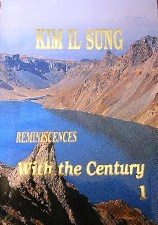 Cover page of the English edition of With the Century, Vol. 1 | |
| Author | Kim Il Sung |
|---|---|
| Language | Korean |
| Subject |
|
| Genre | Autobiography |
| Published | 1992(Korean ed.) |
| Publisher | Pyongyang: Workers' Party of Korea Publishing House (Korean ed.) Pyongyang: Foreign Languages Publishing House (English ed.) |
| Publication place | North Korea |
| Media type | Print in eight volumes |
| Pages | 3,447 (English ed.) |
| OCLC | 28377167 |
| 951.9303/092 B | |
| LC Class | DS934.6.K5 A3 1992 |
| With the Century | |
| Hangul | 세기와더불어 |
|---|---|
| Hanja | 世紀와더불어 |
| RR | Segiwa deobureo |
| MR | Segiwa tŏburŏ |
In a ruined country neither the land nor the people can remain at peace. ... A man who perceives this truth before others is called a forerunner; he who struggles against difficulties to save his country from tragedy is called a patriot; and he who sets fire to himself to demonstrate the truth and overthrows the injust society by rousing the people to action is called a revolutionary.
Contents
Reminiscences: With the Century (Korean : 세기와 더불어) is the autobiography of Kim Il Sung, founder and former president of North Korea. The memoirs, written in 1992 and published in eight volumes, retell Kim's life story through his childhood to the time of Korean resistance. [2] Initially, a total of 30 volumes were planned but Kim Il Sung died in 1994 after just six volumes; the seventh and eight volumes were published posthumously. The work reveals early influences of religious and literary ideas on Kim's thinking. An important part of North Korean literature, With the Century is held as an intriguing if unreliable insight into the nation's modern history under late colonial Korea. The book is considered one of a few North Korean primary sources widely available in the West and as notable research material for North Korean studies.
Authorship of With the Century is disputed, with some claiming that it was written by professional writers instead of Kim Il Sung himself.

